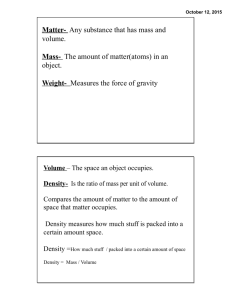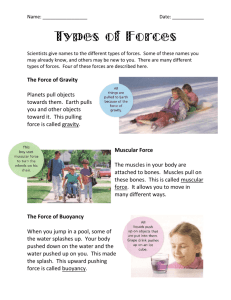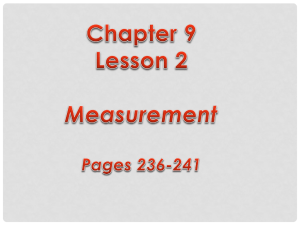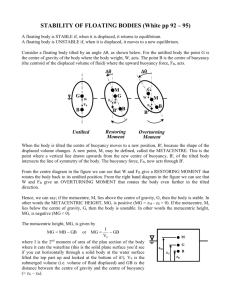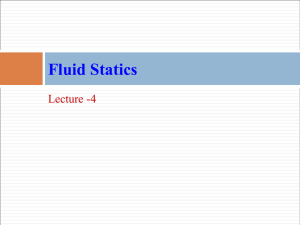S c h o o l o f ... M e c h a t r o n i...
advertisement
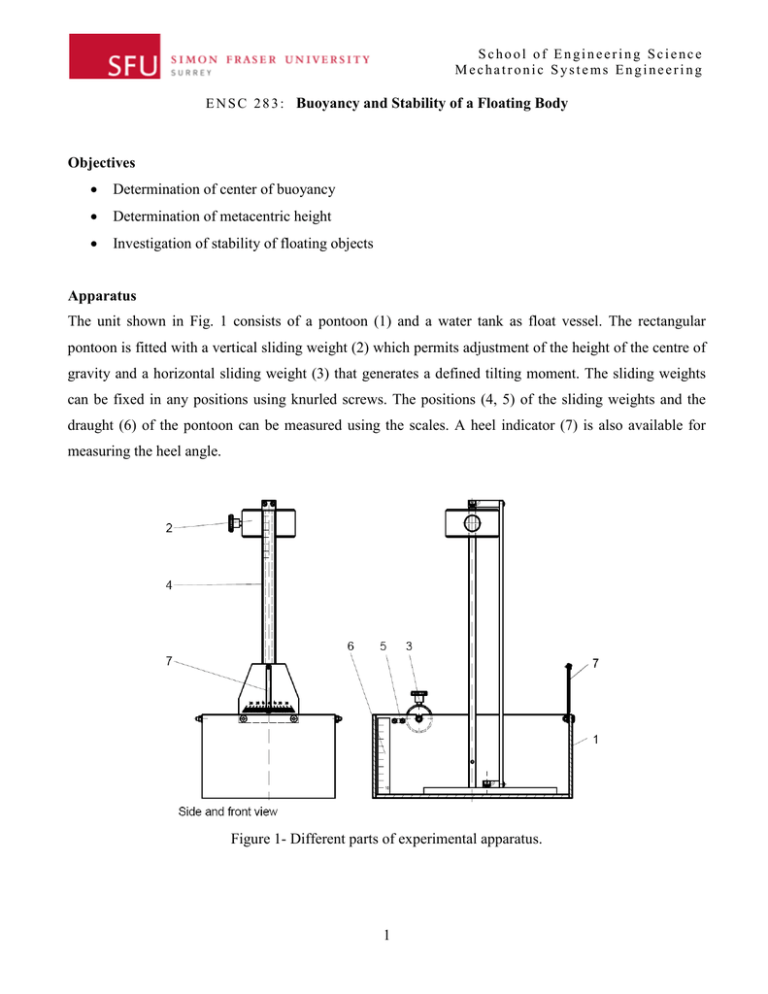
School of Engineering Science Mechatronic Systems Engineering E N S C 2 8 3 : Buoyancy and Stability of a Floating Body Objectives • Determination of center of buoyancy • Determination of metacentric height • Investigation of stability of floating objects Apparatus The unit shown in Fig. 1 consists of a pontoon (1) and a water tank as float vessel. The rectangular pontoon is fitted with a vertical sliding weight (2) which permits adjustment of the height of the centre of gravity and a horizontal sliding weight (3) that generates a defined tilting moment. The sliding weights can be fixed in any positions using knurled screws. The positions (4, 5) of the sliding weights and the draught (6) of the pontoon can be measured using the scales. A heel indicator (7) is also available for measuring the heel angle. Figure 1- Different parts of experimental apparatus. 1 School of Engineering Science Mechatronic Systems Engineering E N S C 2 8 3 : Buoyancy and Stability of a Floating Body Theory Floating bodies are a special case; only a portion of the body is submerged, with the remainder poking of the free surface. The buoyancy, 𝐹𝐴 , which is the weight of the displaced water, i.e., submerged body portion, is equal to its dead weight, 𝐹𝐺 . The centre of gravity of the displaced water mass is referred to as the centre of buoyancy, 𝐴 and the centre of gravity of the body is known as the centre of mass, 𝑆. In Equilibrium position buoyancy force, 𝐹𝐴 , and dead weight, 𝐹𝐺 , have the same line of action and are equal and opposite (see Fig. 2). A submerged body is stable if its center of mass locates below the center of buoyancy. However, this is not the essential condition for stability in floating objects. Figure 2- Buoyancy force and center of buoyancy. A floating object is stable as far as a resetting moment exists in the event of deflection or tilting from the equilibrium position. As shown in Fig. 3, dead weight 𝐹𝐺 and buoyancy 𝐹𝐴 form a force couple with the lever arm of 𝑏, which provides a righting moment. The distance between the centre of gravity and the point of intersection of line of action of buoyancy and symmetry axis, is a measure of stability. The point of intersection is referred to as the metacentre, 𝑀, and the distance between the centre of gravity and the metacentre is called the metacentric height 𝑧𝑚 . Figure 3- Metacentre and metacentric height. 2 School of Engineering Science Mechatronic Systems Engineering E N S C 2 8 3 : Buoyancy and Stability of a Floating Body The floating object is stable when the metacentric height 𝑧𝑚 is positive, i.e., the metacentre is located above the centre of gravity; else it is unstable. The position of the metacentre is not governed by the position of the centre of gravity. It merely depends on the shape of the portion of the body under water. There are two methods of determining the metacenter position. In the first method, the centre of gravity is laterally shifted by a certain constant distance, 𝑥𝑠 , using an additional weight, causing the body to tilt. Further vertical shifting of the centre of gravity alters the heel angle 𝛼. A stability gradient formed from the derivation 𝑑𝑥𝑠 /𝑑𝛼 is then defined which decreases as the vertical centre of gravity position approaches the metacentre. If centre of gravity position and metacentre coincide, the stability gradient is equal to zero and the system is stable. This problem is easily solved graphically (see Fig. 4). The vertical centre of gravity position is plotted versus the stability gradient. A curve is drawn through the measured points and extrapolated as far as it contacts the vertical axis. The point of intersection with the vertical axis locates the position of the metacentre. The metacentric height can also be evaluated theoretically using the following relationship: ���� 𝑀𝑆 = 𝐼𝑜 − ���� 𝑆𝐴 𝑉𝑠𝑢𝑏 (1) where 𝑀, 𝑆, and 𝐴 are metacenter, center of gravity, and center of buoyancy, respectively. 𝐼𝑜 is the area moment of inertia of of the waterline footprint of the body about its tilt axis 𝑜 and 𝑉𝑠𝑢𝑏 is the submerged volume of the body. Figure 4- Graphical determination of metacentre 3 School of Engineering Science Mechatronic Systems Engineering E N S C 2 8 3 : Buoyancy and Stability of a Floating Body For the experimental setup of Fig 5, the first step is to determine the position of the overall centre of gravity 𝑥𝑠 , 𝑧𝑠 from the setting positions of the sliding weights. The horizontal position is referenced to the centre line: 𝑥𝑠 = The vertical position is: 𝑧𝑠 = 𝑚ℎ 𝑥 = 0.055 𝑥 𝑚ℎ + 𝑚𝑣 + 𝑚 𝑚𝑣 𝑧 + (𝑚 + 𝑚ℎ )𝑧𝑔 = 5.364 + 0.156 𝑧 𝑚ℎ + 𝑚𝑣 + 𝑚 (2) (3) Total weight (not including sliding weights m v and m h ), m=2770 g Figure 5- Position and size of sliding weights And the stability gradient is: Procedure 𝑑𝑥𝑠 𝑥𝑠 = 𝑑𝛼 𝛼 (4) • Set the horizontal sliding weight to position x = 8cm. • Move vertical sliding weight to bottom position. • Fill the tank with water and insert the floating body. • Gradually raise vertical sliding weight and note down the tilting angle. Plot stability gradient versus vertical center of gravity position and using the plot determine the metacentric height. Compare the result with the metacentric height calculated from Eq. (1). 4 School of Engineering Science Mechatronic Systems Engineering E N S C 2 8 3 : Buoyancy and Stability of a Floating Body Raise the vertical sliding weight until the floating apparatus reach the instability point and record this data point. Compare it with your previous results. Discussion 1- What will happen if the center of gravity and the center of buoyancy of a floating object are the same? 2- When and why will the floating object become unstable? Compare theoretical expectations to your lab observations and discuss any differences. 3- Derive and measure the buoyancy force exerted to the experimental setup when the vertical weight is at the bottom and the horizontal weight is at the center. 4- Derive equations (2) and (3). 𝑧𝑠 3cm 6cm 9cm 𝛼 𝑚 = 2770 𝑔𝑟 𝑚ℎ = 193 𝑔𝑟 𝑚𝑣 = 550 𝑔𝑟 𝑥𝑠 = 8 𝑐𝑚 5 𝑥𝑠 /𝛼
